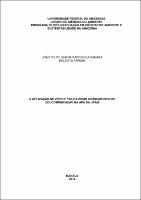| ???jsp.display-item.social.title??? |


|
Please use this identifier to cite or link to this item:
https://tede.ufam.edu.br/handle/tede/6587| ???metadata.dc.type???: | Dissertação |
| Title: | A utilização de vídeo e trilha como instrumentos de Educomunicação na APA da UFAM |
| ???metadata.dc.creator???: | Câmara, João Felipe Omena Raposo da  |
| ???metadata.dc.contributor.advisor1???: | Lima, Vilma Terezinha de Araújo |
| First advisor-co: | Marchand, Guillaume |
| ???metadata.dc.description.resumo???: | Diversos instrumentos de comunicação podem ser utilizados como ferramentas educativas, complementando assuntos ministrados em sala de aula e promovendo a aproximação entre os estudantes e o objeto de estudo. Esse aproximação se dá por meio de uma didática participativa e pautada na utilização de instrumentos de comunicação que retratem a realidade dos estudantes, e é chamada Educomunicação. A presente pesquisa utilizou-se de dois instrumentos de educomunicação sobre a Área de Proteção Ambiental na qual a Universidade Federal do Amazonas está inserida: um vídeo educativo e uma trilha interpretativa. Tais instrumentos foram apresentados aos estudantes e em seguida o conhecimento adquirido por eles foi avaliado. A avaliação da eficácia do vídeo educativo e da trilha interpretativa como instrumentos de educomunicação constitui o objetivo principal da seguinte pesquisa. Os alunos responderam um questionário com questões fechadas sobre o conhecimento relacionado à APA da Ufam e algumas das espécies vegetais ali presentes. Em seguida, assistiram ao vídeo e participaram da atividade na trilha, e tornaram a responder o questionário. Foram escolhidas turmas aleatórias de diferentes cursos do Campus para participar da pesquisa. A comparação dos resultados dos questionários de antes e depois das atividades, bem como o comportamento e as reações dos alunos durante o vídeo e a trilha indicaram que o vídeo é mais eficaz na fixação dos conteúdos abordados. No entanto, a trilha interpretativa foi mais eficaz para sensibilizar os estudantes quanto à necessidade de conservação das áreas florestais nas cidades. De uma amostragem de 255 alunos, apenas 6% (16) responderam saber que a floresta do Campus está em uma unidade de conservação. Ou seja, um pequeno percentual dos estudantes sabe que a floresta do Campus é uma área protegida. A inserção direta no fragmento florestal e a exibição de conteúdos voltados para a realidade local dos estudantes são importantes no despertar da curiosidade que os levará a ter uma maior atenção em relação às questões ambientais. Por isso, conclui-se que a utilização dos instrumentos de educomunicação para tal fim não é somente eficaz, como também extremamente necessária. |
| Abstract: | Many communication instruments may be used as educative tools, in addiction to the contents shown in class and promoting the approximation between the students and the studied objects. To name the utilization of such tools in the educative process, was created the term “educommunication”. This educative proposition has as main goal to familiarize the students to the taught contents, by using a participative didactic, based in the utilization of communicative instruments that shows their realities. The following research has used two instruments, the educative video and the trail within the forest, about the Environmental Protected Area in which the Amazonas Federal University is located. Such instruments were presented to the students and the knowledge acquired by the students was measured. The evaluation of the efficacy of both instruments constitutes the main goal of the research. The students answered a questionnaire related to the environmental protected area and about its species. Afterword, they have watched the video or gone to the trail, and answered the questionnaire one more time, and the results were compared. Was chosen aleatory classes of different majors to participate of the research. The comparison of both results, such as the behavior and reactions of the students during the video or the trail indicates that the video is most effective in fixing the contents, Nevertheless, the trail is most effective to make the students realize about the importance of protecting the environment. Only 6% (16) od 225 students have answered that already known that the Campus is located within a protected area. The insertion of them in the forestall fragment and the exhibition of contents related to the local reality of the students are important to develop their curiosity which will lead them to have more attention about the environmental questions. So, It is necessary techniques of educommunication, which is not only effective, but also necessary, to despertate the environmental conscience of the students. |
| Keywords: | Educomunicação Unidades de conservação Área de Proteção Ambiental |
| ???metadata.dc.subject.cnpq???: | CIÊNCIAS AGRÁRIAS |
| Language: | por |
| ???metadata.dc.publisher.country???: | Brasil |
| Publisher: | Universidade Federal do Amazonas |
| ???metadata.dc.publisher.initials???: | UFAM |
| ???metadata.dc.publisher.department???: | Faculdade de Ciências Agrárias |
| ???metadata.dc.publisher.program???: | Programa de Pós-graduação em Ciências do Ambiente e Sustentabilidade na Amazônia |
| Citation: | CÂMARA, João Felipe Omena Raposo da. A utilização de vídeo e trilha como instrumentos de Educomunicação na APA da UFAM. 2014. 81 f. Dissertação (Mestrado em Ciências do Ambiente e Sustentabilidade na Amazônia) - Universidade Federal do Amazonas, Manaus, 2014. |
| ???metadata.dc.rights???: | Acesso Aberto |
| ???metadata.dc.rights.uri???: | http://creativecommons.org/licenses/by-nc-nd/4.0/ |
| URI: | https://tede.ufam.edu.br/handle/tede/6587 |
| Issue Date: | 31-Jul-2014 |
| Appears in Collections: | Mestrado em Ciências do Ambiente e Sustentabilidade na Amazônia |
Files in This Item:
| File | Description | Size | Format | |
|---|---|---|---|---|
| Dissertação_João Felipe Camara | 1.83 MB | Adobe PDF |  Download/Open Preview |
This item is licensed under a Creative Commons License





